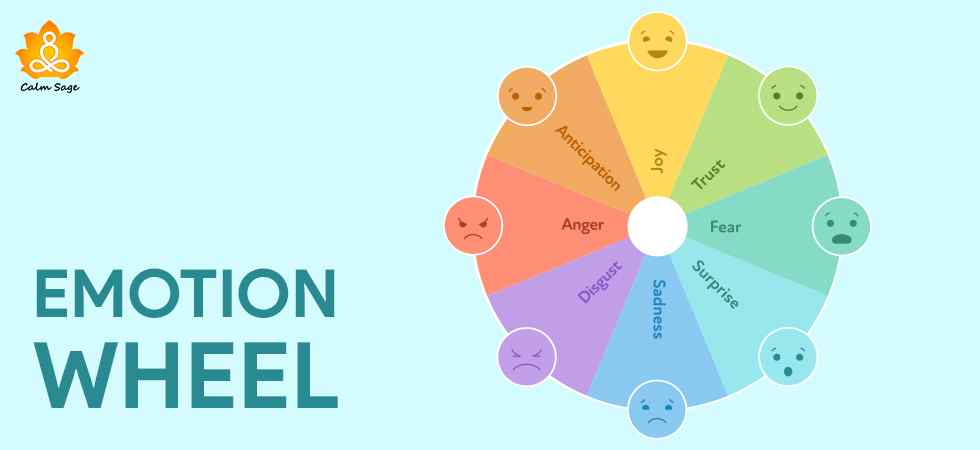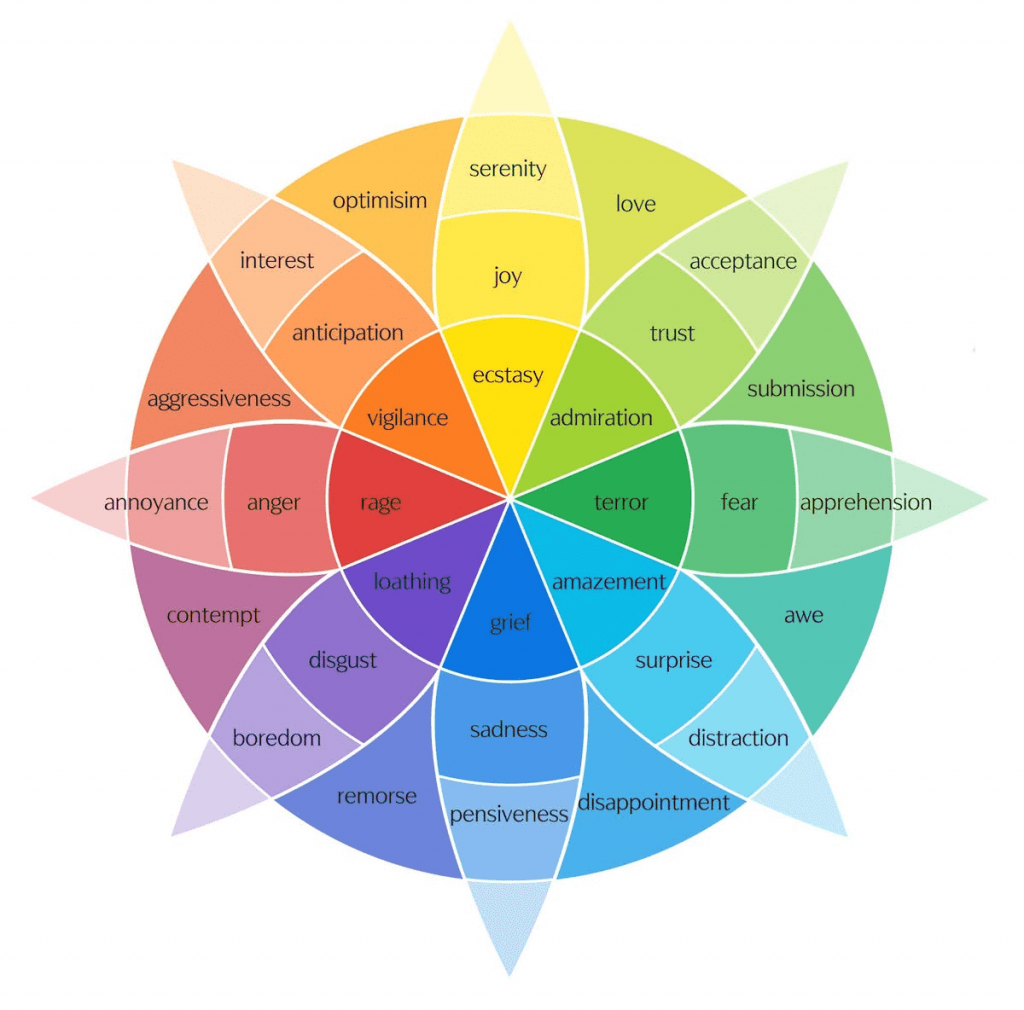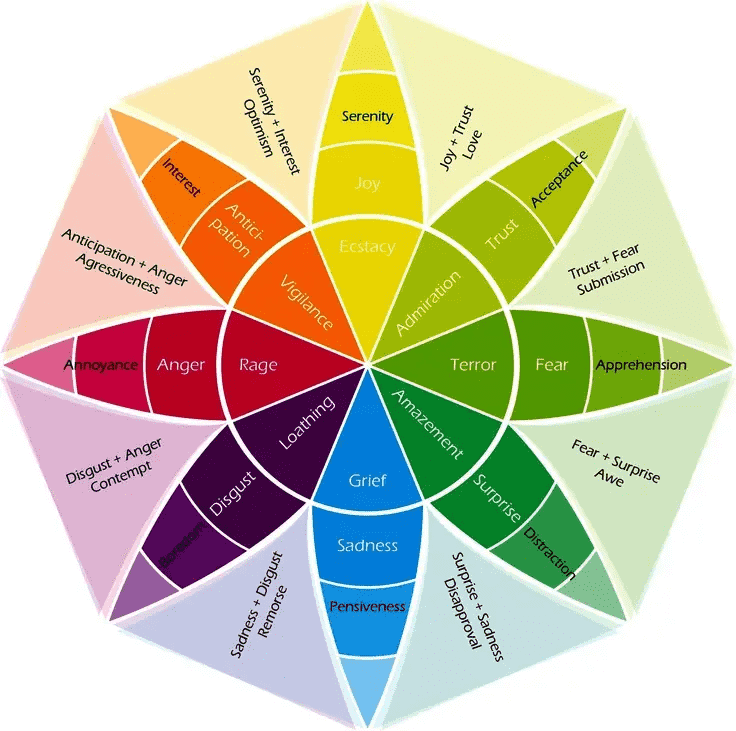The Emotion Wheel: Primary Emotions, Benefits & How To Use It!

I am sure you must have heard of an emotion wheel before but do you know what it is used for? The emotion wheel is a model which was first developed in the early 1980’s and since then there have been quite a few emotion wheel models developed.
The main idea behind an emotion wheel is to see how our emotions are connected and how one of our emotions has an influence on the other. By using the emotion wheel you can also find out the primary emotions on which you function.
Now, we all know that there are a lot of emotions an individual can experience. In one of the pioneering studies, it was found that humans experience around 27 emotions but at that time they were unaware that two emotions can combine and form a third emotion.
The question here is how an individual can unfold the mystery of what’s causing their emotional outbursts and overwhelming emotional floods with so many known emotions and unknown combined emotions.
Experts found the solution is ‘The Emotion Wheel’! Let’s learn more about the emotion wheel and its components…
What Is An Emotion Wheel?

The emotion wheel is a type of psychological tool that not only helps you identify your complex emotions but also helps you verbalize them. It is a 2-dimensional model inclusive of all possible emotions an individual can experience.
Dr. Robert Plutchik (an American psychologist) was one of the pioneers in creating the emotion wheel. He studied emotions for many years and identified eight primary emotions which form the base for all other emotions and feelings that an individual experiences.
Differing from the initial count of the number of emotions an individual experiences (27), it was found that we can experience around 34,000 distinct emotions. It is extremely difficult to know these many emotions and pinpoint which one you’re experiencing.
That’s when the emotion wheel comes into play. The emotion wheel is a representation of most of the emotions experienced by humans, highlighting the primary emotions and the foundation. The emotion wheel helps you especially when you are experiencing intense feelings and you are clueless about why you’re feeling this way and what you should do now.
Also read Fear of Expressing Emotions or Feelings: Animotophobia
To understand the emotion wheel you first need to know the eight primary emotions. Let’s have a look at them…
The Eight Primary Emotions From The Plutchik Emotion Wheel
Humans feel a lot of emotions but Plutchik claims that most of these emotions fall in the spectrum of intensity of the eight primary emotions. This means you experience secondary and tertiary emotions as well but all are somewhere coming from the eight primary emotions.
These eight primary emotions are placed right in the center of the emotion wheel and the remaining layers follow the intensity trail. Let’s look at the primary emotions before we move further into the emotion wheel;
- Sadness: this is the first primary emotion, it originates in an infant when they are separated from their caregiver or experience the stress of being separated. It includes feelings like sorrow, depression, hopelessness, lethargy, discontentment, apathy, loneliness, etc. Joy is a contrasting emotion to sadness.
- Anger: the feelings of anger can be referred to as the discomfort, fear, or harm one is subjected to. Anger includes feelings of hostility, aggression, dissatisfaction, rage, etc. The contrasting emotion of anger will be fear.
- Disgust: disgust can be referred to as the feeling so not liking something/someone. The feeling is so unpleasant that you take an avoidance approach to deal with it. Disgust includes feelings of revulsion and aversion. The contrasting emotion of disgust is trust.
- Joy: joy can be referred to as the feeling of being content when all that you are doing and all the things you have achieved. You feel joy when everything seems to fall into place. It is inclusive of feelings like a deep sense of contentment, elation, triumph, euphoria, jubilation, etc. The contrasting emotion for joy will be sadness.
- Trust: trust is an emotion that makes you feel confident about your relationship with other people. You know that the energy that you invest in people you trust will always be fruitful. It includes feelings of belief, hopefulness, safety, positivity, etc. The contrasting emotion to trust is disgust.
- Fear: biologically speaking, fear is an emotion that acts as a protective shield as it signals you to not engage in things that involve danger. Fear is inclusive of feelings like apprehension, worry, uncertainty, nervousness, anxiety, terror, etc. The contracting emotion for fear will be anger.
- Surprise: Surprise refers to the feeling you experience when something takes place out of your expectation. Something that you never imagined happening, can make you experience surprise. It includes feelings of amusement, wonderment, speechlessness, shock, disbelief, etc. The contrasting emotion to surprise is anticipation.
- Anticipation: the anticipation emotion is experienced when you kind of know what might happen, it’s when you are aware of the consequence of your actions. The feelings of anticipation include excitement, irritation, expectations, uncertainty, enthusiasm, pleasure, etc. The Contrasting emotion to anticipation is a surprise.
Also read What Is Emotional Acceptance? How To Accept Emotions?
How To Use The Emotion Wheel?

You can use the emotion wheel however you wish to because there is no said method of using the emotion wheel. In fact, experts say that there is no correct or incorrect way of using the emotion wheel because it all depends on the interpretation you draw from them.
However, they also talk about some tips that you can keep in mind while using the emotion wheel. Let’s have a look at them;
1. Begin with identifying your core emotion (primary emotion): it’s important to know what you are feeling and how your mind and body are reacting to it. To do so you need to identify the main emotion lying underneath all your overwhelming feelings which you will find in the wheel of emotions.
Sometimes it’s difficult to pinpoint the exact emotion so with the help of the wheel of emotion you can choose from the variety of emotions that suits your current mood. When you look at the wheel of emotions you will find four layers inclusive of different emotions with different intensities, you have to pick out one that best suits your feelings.
Layers of the wheel of emotions
- Outer edges: Low-intensity emotions
- Toward the center: Mild-intensity emotions
- Center circle: High-intensity emotions
- Between each colored spoke: Mixed emotions
For example you have been feeling discomfort since morning, you look at the emotion wheel and look for the emotions you associate with the most. Let’s say you resonate with fear and anticipation. That’s how you find your core emotions.
2.Look for possible causes: once you have identified your emotions you have to look for possible causes. What is making you feel the way you are feeling right now? Now that you have crossed one hurdle of recognizing what you are feeling it’s time to follow the trail and get a better understanding of why you are feeling these emotions.
Name the emotion you identified and look at all the things that happened that could have triggered the emotion. It might take some time so be calm and relaxed while you do this.
3.Connect your findings: you have almost come to the end of understanding your emotions and the response they generate. You have your core emotion with you and you have a list of things or situations that might have triggered the emotion. All you have to do is try to find a connection between your emotion and the triggers.
Taking the previous example, you are feeling discomfort since morning and upon checking the emotion wheel you resonated most with fear and anticipation. The trigger that you found was an argument with your partner. When you try to connect all these you will notice that you love your partner and the argument has instilled fear in you because you’re afraid of losing them. Now when you look at love in the emotion wheel, it includes feelings of serenity, joy, acceptance, and trust. This means at this moment you might feel discomfort but you still love and trust your partner.
4.Take effective action: now that you are completely aware of what emotions you are experiencing ad why you are experiencing them, it’s time to act accordingly. An emotion wheel is a psychological tool that helps you understand difficult emotions and makes it clear to you what you should be doing. In fact, once you have identified the motion and recognized the cause, it will automatically reduce some stress and make you feel better.
Also Read Are You Experiencing Uncomfortable Emotions? Try These Healthy Coping Mechanisms
The Benefits Of Using The Emotion Wheel
Processing your emotions is very important for your emotional well-being. Many of us are not able to successfully process our emotions just because we don’t really understand what we are feeling. The emotion wheel solves this problem, it helps you in identifying your emotion as well as help you get to the core of your feelings and emotions.
Other than this there are some other benefits of using the emotion wheel, let’s have a look at them;
- When you know your emotions well, you don’t engage in overthinking
- The emotion wheel helps you connect with your underlying emotions
- Using the emotion wheel regularly makes you emotionally mature and helps in reducing conflict
- The emotion wheel helps you realize that each emotion has something important to tell you
- It helps you understand that there is nothing wrong with you
That’s All Folks!
I hope you found this blog about the emotion wheel interesting and helpful. I highly recommend giving the emotion wheel a try if you are someone who struggles with dealing with difficult and intense emotions. Do share this information on how to use the emotion wheel with your friends and family so that it’s easy to use for the first time.
Thanks for reading.
Take care and stay safe.




















